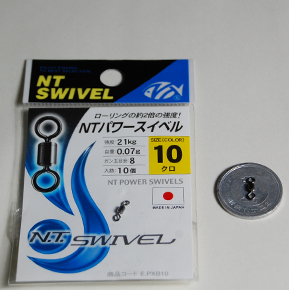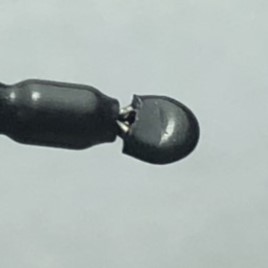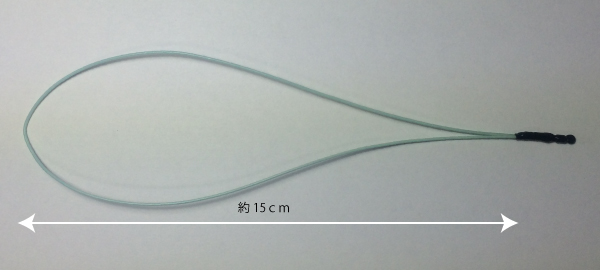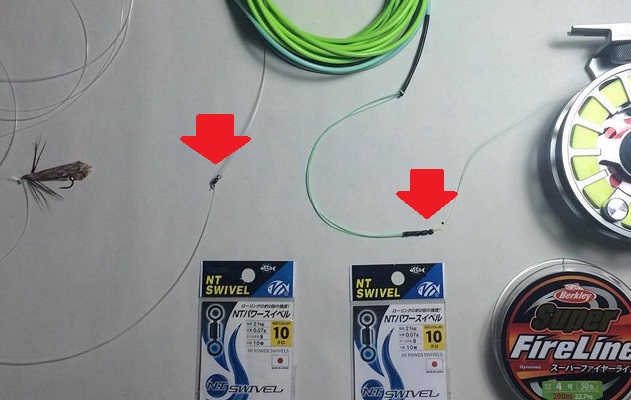Trouble-free with correct operation and settings!
If you don’t build a line system
If you cast and retrieve in spiral mode without building a line system, the running line will always be twisted.
If you continue to cast as it is, if you throw 10 throws, the twist will become stronger and it will cause line trouble and it will hinder fishing.
Therefore, I would like to introduce the mechanism of the line system that opens the line twist.
It doesn’t matter how many you throw if you build a line system. You can keep throwing it all day long.
Since the fly itself does not rotate, it does not affect the hit rate.
Fly line
There are various lines, but considering the casting surface, operability in the stream, retrieve, etc., it is recommended to use a short overall length type that can attack a wide range efficiently and gain a long distance.
Running line
For various PE line systems, select one that is antinomy but thin and has as strong a tension as possible (the stronger the tension, the stronger the force of the line itself to return the twist).
As of 2020, we recommended the Berkeley’s Super Fire Line (starting at Lb 50).
It can also be used on ordinary PE lines. However, I do not recommend it very much. There is a clear difference in performance.
When using with a double hand rod
We strongly recommend using it on the Super Fire line (starting at 50 pounds).
Click here for the manufacturer site ↓
http://www.purefishing.jp/product/Line/super_fireline.html
When using with a single hand rod
Yotsuami’s Odds Port No. 4 (70 pounds) is recommended
Odds Port No. 4 can also be used with a double hand rod.
Click here for the manufacturer site ↓
Another single recommendation is that I can’t find the manufacturer’s site, but the 60LB (actual strength 79.2LB) of the product GAMBIT BASS LINE G7 SUPER PE is also a little thicker and easier to handle than the above odds port 4, so it’s a single. Recommended for.
It’s as short as 75m, but you can use it if you want to use it even if it’s double.
* If you do not need a flight distance, you can also use it on a monocore running line. (However, the flight distance of the mono core does not increase)
Rods that can be used: Single hand, switch rod, double hand, any rod can be used. Casts with hole movements can also be cast in spiral mode.
swivel
It is the most important point. Moreover, not all of them are acceptable. There are three main conditions.
1. Rotational performance
2. Strength
3. Size
If you do not clear these three conditions, it will not work well.
This fishing method has become possible because the swivel’s twisting ability has improved dramatically through many years of trial and error and repeated technological innovations by excellent Japanese companies.
NT power swivel
This swivel is the strongest. There is no mistake.
MADE IN JAPAN quality. The performance ratio with others is outstanding!
If you are thinking of using Spiral Mode, we will assume that you will use it with this swivel.

This swivel is extremely small in size, weighs 0.07g, but has a strength of 21kg, and achieves extremely smooth ultra-high-speed rotation (rotation speed is completely different from other products). It is also perfect in terms of durability.
* (Since its own weight is 0.07g, the dry fly will not sink even if it is attached to the second setting point described later.)
If this very high performance swivel was invented before the introduction of spinning reels, wouldn’t it have been invented? .. .. .. I don’t think it’s a thing, but it’s an excellent twisting ability that makes me think that the appearance was delayed considerably.
Processing swivels
Since the swivel passes through the guide, it is recommended to coat it with a heat shrink tube just in case.

Swivel loop connector
By making one side into a large loop as shown below, it is convenient to replace the fly line while it is still in the line wallet.

Swivel loop connector
1,800JPY for 3 pieces per set
Overall view of the line system

There are two places to set
(1st place) Swivel loop connector at the joint between the fly line and the running line (on the right side of the screen)
(2nd place) Swivel as it is at the joint between the leader and the tippet (left side of the screen)
Set. When retrieving or drifting, the swivel (at the first location) functions to absorb rotational energy. (The fly line and fly do not rotate at all at the first place)
Meaning of using swivels in two places
Actually, in order to catch fish, the swivel can be used only at one place of the swivel loop connector.
Not to mention the fly line, the fly does not rotate at all, so the effect on the fishing result is zero.
Then, what is the reason for (the second place) … The fish hits and finally lands. Of course, when landing, the weight of the fish will be applied to the line. Due to the relationship between this weight and line tension, a certain amount of twist affects the entire line as rotational energy only during landing. After the landing, the tippet part will be affected by the twist (it may not come out), so set the swivel (2nd place) to remove it.
If line trouble occurs
* If line trouble occurs, it is not a line twist, but a case where the yarn is wound in a fluffy state (dubbed state) and cast without applying tension when winding the thread, as in the case of spinning reels. (Not everything will be in trouble, and someday it will lead to trouble)
If you cast in such a state and a lump of thread that cannot be repaired is formed, you can immediately restore it by cutting the lump and reconnecting it.
If you remember the operation correctly, there will be no trouble at all..
As with anything, it takes some getting used to. One example is the backlash of bait casting reels.
However, it is not as difficult as bait casting reels. Before you get used to it, you tend to be alert and loosely (fluffy). (Especially in water stagnation areas such as managed fishing spots and lakes, it is easy to forget to keep tension)
* The trick is to wind it up without dub. If you do this thoroughly, it will be completely non-trouble. It’s all about winding, not casting.
When winding the line on the spool, as long as you hold the line with your fingers and feel the appropriate tension (do not loosen and wind), no line trouble will occur. Once you get used to it, you will be able to know the moment of loose winding (the moment of improper winding) without looking at the spool.
In concrete terms, the moment you wind it loosely, a slight vibration is transmitted. If you feel it, stop the retrieve, reverse the spool, and make a habit of rewinding the loose part.